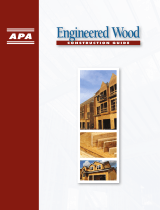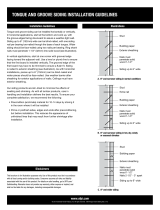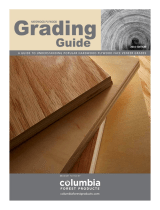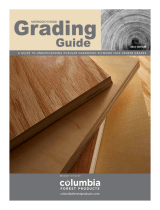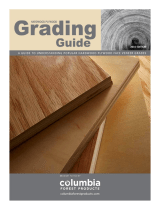
ENGINEERED WOOD CONSTRUCTION GUIDE
■
FORM NO. E30V
■
© 2011 APA – THE ENGINEERED WOOD ASSOCIATION
■
WWW.APAWOOD.ORG
62
Roof Construction
only. Special conditions, such as heavy con-
centrated loads, may require constructions in
excess of these minimums, or allowable live
loads may have to be decreased for dead loads
greater than 10 psf, such as tile roofs. Panels
are assumed continuous over two or more
spans with the long dimension or strength
axis across supports.
Good performance of built-up, single-ply, or
modified bitumen roofing applied on low slope
roofs requires a stiffer deck than does prepared
roofing applied on pitched roofs. Although
APA Span-Rated panels used as roof sheathing
at maxi mum span are adequate structurally,
an upgraded system is recommended for low
slope roofs. Table 31 provides recommended
maximum spans for low slope roof decks.
Recommended live loads can be determined
TABLE 31
RECOMMENDED MAXIMUM SPANS FOR APA PANEL ROOF
DECKS FOR LOW SLOPE ROOFS
(a)
(Panel strength axis
perpendicular to supports and continuous over two or more spans)
Grade
Minimum Panel
Performance
Category
Minimum
Span
Rating
Maximum
Span
(in.)
Panel Clips
Per Span
(b)
(number)
APA RATED
SHEATHING
15/32 32/16 24 1
19/32 40/20 32 1
23/32 48/24 48 2
7/8 60/32 60 2
APA RATED
STURD-I-FLOOR
19/32 20 oc 24 1
23/32 24 oc 32 1
7/8 32 oc 48 2
(a) Low slope roofs are applicable to built-up, single-ply and modified bitumen roof-
ing systems.
For guaranteed or warranted roofs contact membrane manufacturer
for acceptable deck. Low-slope roofs have a slope that is less than 2/12 (2"/foot).
(b) Edge support may also be provided by tongue-and-groove edges or solid
blocking.
TABLE 32
RECOMMENDED MINIMUM FASTENING SCHEDULE
FOR APA PANEL ROOF SHEATHING (Increased nail
schedules may be required in high wind zones and
where roof is engineered as a diaphragm.)
Panel
Performance
Category
(c)
Nailing
(a)(b)
Size
(d)
Maximum Spacing (in.)
Supported
Panel Edges
(e)
Intermediate
3/8 − 1 8d 6 12
(f)
1-1/8 8d or 10d 6 12
(f)
(a) Use common smooth or deformed shank nails for panels with
Performance Category 1 or smaller. For 1-1/8 Performance
Category panels, use 8d ring- or screw-shank or 10d common
smooth-shank nails.
(b) Other code-approved fasteners may be used.
(c) For stapling asphalt shingles to Performance Category 3/8 and
thicker panels, use staples with a 15/16-inch minimum crown
width and a 1-inch leg length. Space according to shingle manu-
facturer’s recommendations.
(d) See Table 5, page 14, for nail dimensions.
(e) Supported panel joints shall occur approximately along the
centerline of framing with a minimum bearing of 1/2". Fasteners
shall be located 3/8 inch from panel edges.
(f) For spans 48 inches or greater, space nails 6 inches at all
supports.
Notes: Gluing of roof sheathing to framing is not recommended,
except when recommended by the adhesive manufacturer for roof
sheathing that already has been permanently protected by roofing.
The Span Rating in the trademark applies when the long panel dimen-
sion or strength axis is across supports unless the strength axis is oth-
erwise identified.
FIGURE 21
APA PANEL ROOF SHEATHING
Notes:
1. Cover sheathing as soon as possible with roofing felt for extra
protection against excessive moisture prior to roofing application.
2. For pitched roofs, place screened surface or side with
skid-resistant coating up if OSB panels are used. Keep roof
surface free of dirt, sawdust and debris, and wear skid-resistant
shoes when installing roof sheathing.
3. For buildings with conventionally framed roofs (trusses or rafters),
limit the length of continuous sections of roof area to 80 feet
maximum during construction, to allow for accumulated expansion
in wet weather conditions. Omit roof sheathing panels in each
course of sheathing between sections, and install “fill in” panels later
to complete roof deck installation prior to applying roofing.
APA RATED
SHEATHING
1/8" spacing is
recommended at all
edge and end joints
unless otherwise
indicated by panel
manufacturer
Stagger
end joints
(optional)
Panel clip or tongue-and-groove
edges if required
Asphalt or wood
shingles or shakes.
Follow roofing manufacturer’s
recommendations for roofing felt.
Protect
edges of
Exposure 1
panels against
exposure to
weather, or use
Exterior panel
starter strip
panel
clip
Strength axis














